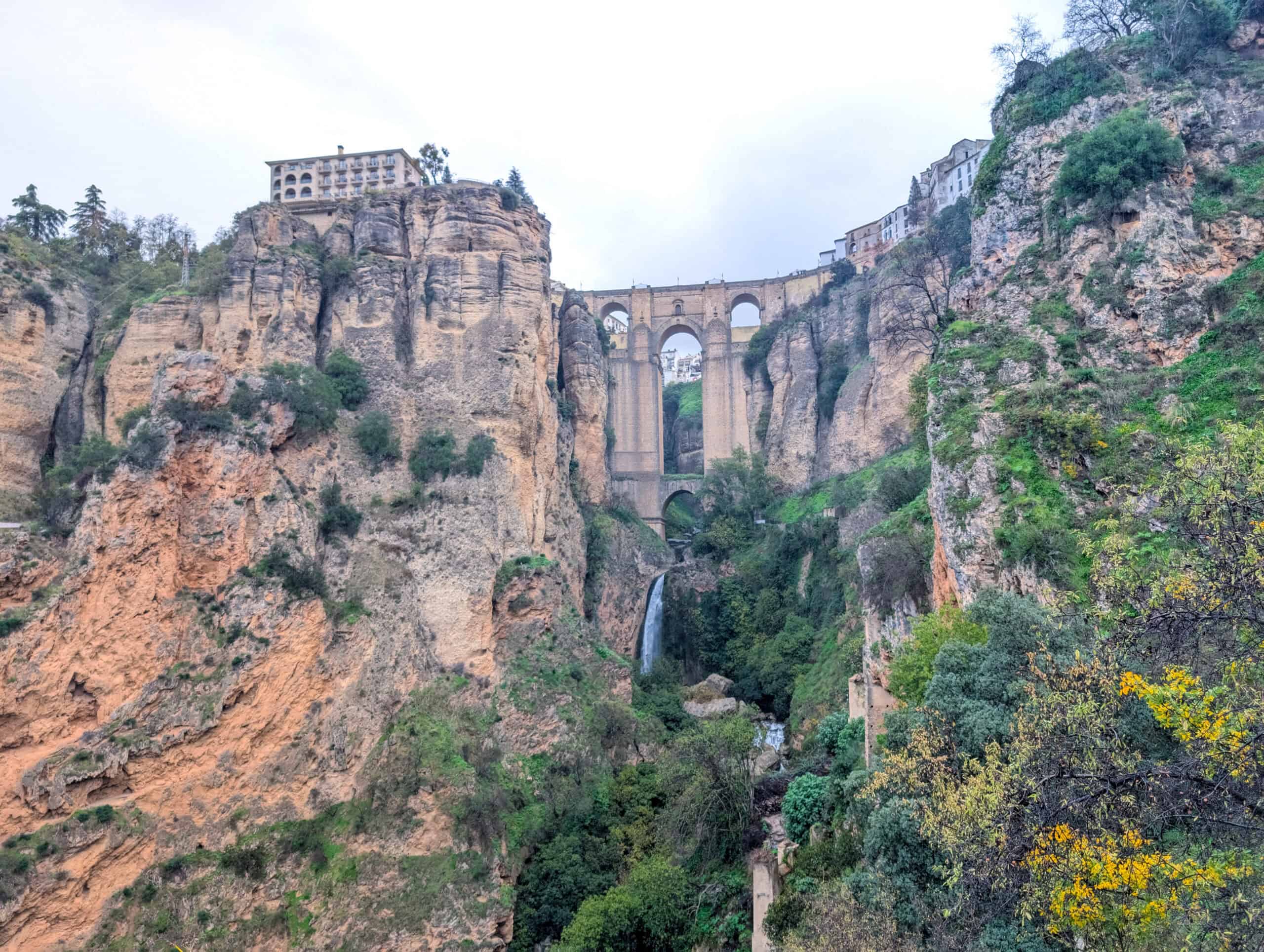Is Ronda, Spain Worth Visiting? Discover Its Best Sights and Hidden Gems
Are you wondering if Ronda is worth visiting on your trip around Spain? Read on to learn why this pretty little town is worth a stop on your itinerary.
Ronda, one of the oldest towns in Spain should definitely be on your Andalusia itinerary. A gorgeous town to walk around, Ronda is perched on a cliff in the Andalusian highlands, split in half by the dramatic El Tajo gorge. As one of the villages within Sierra de las Nieves National Park and flanked by two more national parks in the West and South, Ronda has a stunning mix of natural beauty and historical charm, making it stand out even in a region packed with incredible destinations like Seville, Cordoba, Marbella and Granada.
Ronda has seen many cultures influence it – from the Celtics who established the town in the 6th century, the Phoenicians, the Romans, Islam from across the strait and Christianity. Its buildings reflect the marrying of Islamic (Moorish) and Christian architecture. It is small enough to walk around in a few hours or a day but packed with enough things to do to make you want to stay for at least a couple of days.
Ronda is worth visiting if you’re into history, culture, hiking, photography or exploring unique places – its stunning location on the edge of the El Tajo gorge makes it an incredible visual experience.
One Day in Ronda, Spain
Here’s the best ways to spend 1 day in Ronda, including the top things to do and see.
Puente Nuevo (New Bridge)
This bridge is what put Ronda on travelers’ maps! You can stare 120 meters into the chasm of the river canyon from this bridge, or choose to descend into its depth while learning more about the bridge and Ronda itself for a €2.5 fee (tickets can be bought to the interpretation center online). You can also gaze at the bridge closely from the Puente Nuevo viewpoint or mirador beside the bridge. The best views of the bridge though are from other miradors and a separate observation deck built to view the bridge itself.
Pro Travel Tip: Tour groups flood the bridge area from about 11:00am to 4:00pm. If you’re traveling on your own schedule, plan to visit early in the morning or late afternoon/early evening.
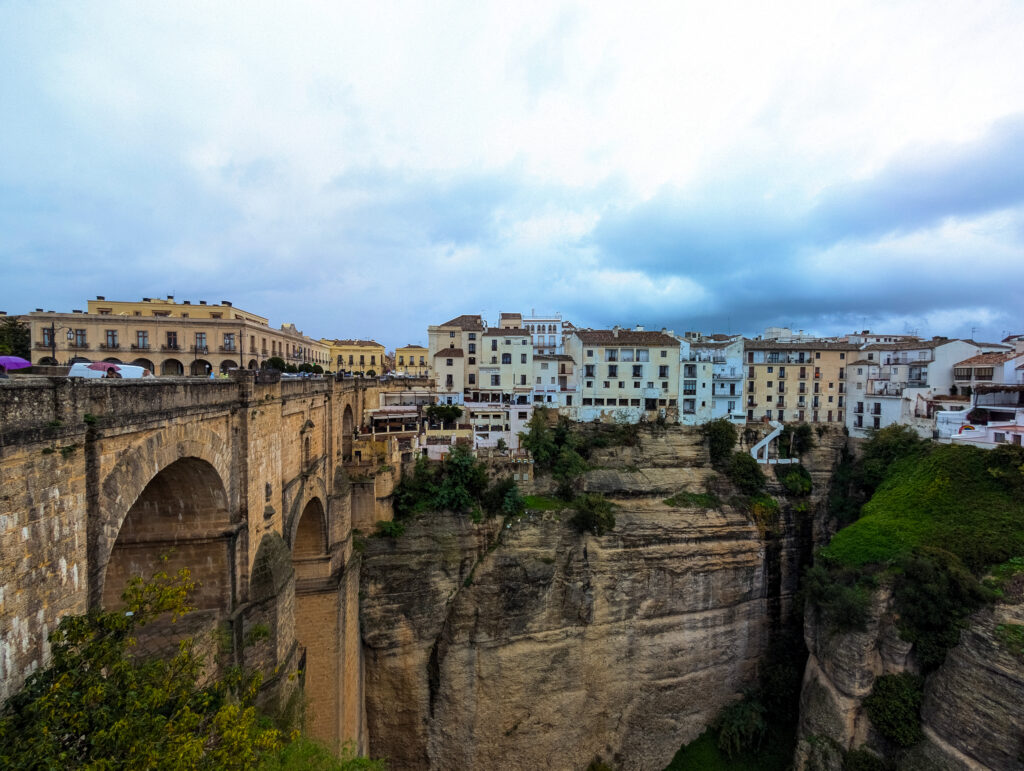
Mirador Del Viento or further down to Arabic Arch
The best thing to do in Ronda is descend into the gorge, to look up at the Puente Nuevo bridge. Choose to take a short walk down to the Mirador Del Viento, which is an observation deck specially built for tourists or continue to descend down the path towards the Arabic Arch for a an even better view.
The views get better the further you descend and you can choose to continue hiking down from Arabic Arch to the bottom of the canyon to the Guadalevin river. Alternatively, you can also continue to take a path down to Mirador La Hoya Del Tajo. We did not choose to do this on the day, as there was a storm system in the area with rain, thunder and lightning, making the paths extremely slippery.
Pro Travel Tip: The path down to the observation deck and further is short but steep and takes about 20 minutes down to Arabic Arch from Puente Nuevo. You will also have to come back the same way. Do this bit after exploring Ronda’s old town and get a packed sandwich or some tapas before descending. Make a picnic out of your hike and have lunch at the walls of the Arabic Arch or at the river while looking up at Ronda and Puente Neuvo.

Jardines de Cuenca / Mirador de Cuenca
This viewpoint and the walk along the walls down to Puente Viejo or the Old Bridge, is the older bridge in Ronda, built in the 16th century. This walk and Mirador de Cuenca has the best views of the Puente Neuvo bridge which is the most recognizable landmark in Ronda. There is also a little garden or grounds on the walk and is a perfect place for a packed lunch. Definitely do this walk if you want to avoid the steeper walk down to Mirador Del Viento.
Pro Travel Tip: Do this walk before 11 am or post 4pm / sunset to avoid crowds.
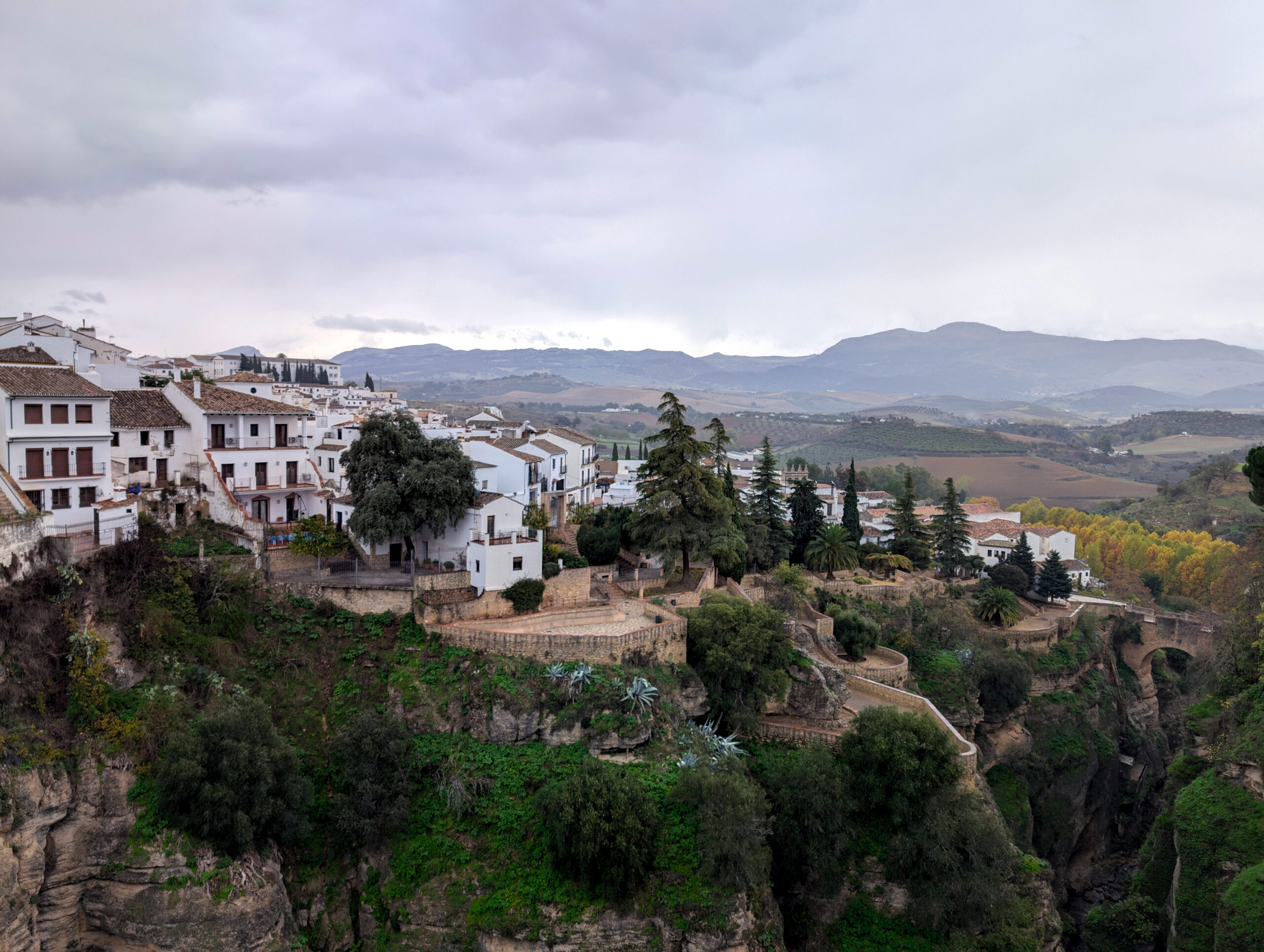
Ronda’s Old Town (La Ciudad)
Ronda’s old town is great to walk around and observe the Puente Nuevo bridge, which is the dominant landmark in this town, from various angles. The old town also has many examples of Moorish architecture, a common theme across Andalusia. A walking tour is a great way to learn about Ronda’s history, the Moorish influence and its economy today. We recommend the group or private tours with Antonio, who was a great guide.
Pro Travel Tip: If you aren’t doing a guided walking tour, use our Ronda Highlights Map below to guide you through some highlights of Old Town.
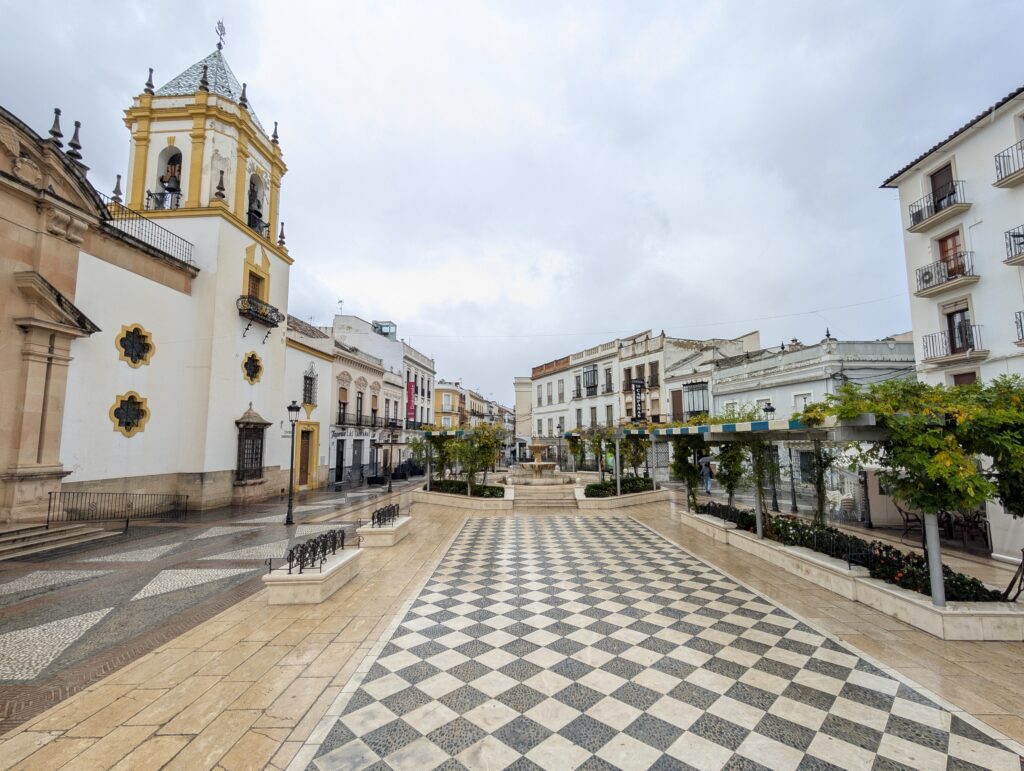
Plaza de Toros de Ronda (Bullring of the Royal Cavalry of Ronda)
Andalusia and Ronda have a proud bullfighting tradition and you can see symbols of that through plaques through town. However, Ronda also has the oldest bullring in Spain. The Plaza de Toros de Ronda is a beautiful neoclassical style bullring built in 1785. While it isn’t the biggest bullring, it is exquisitely charming.
The visit costs €9 / €11 with / without an audio guide and includes a visit to the museum inside. You can buy tickets online at their official site.
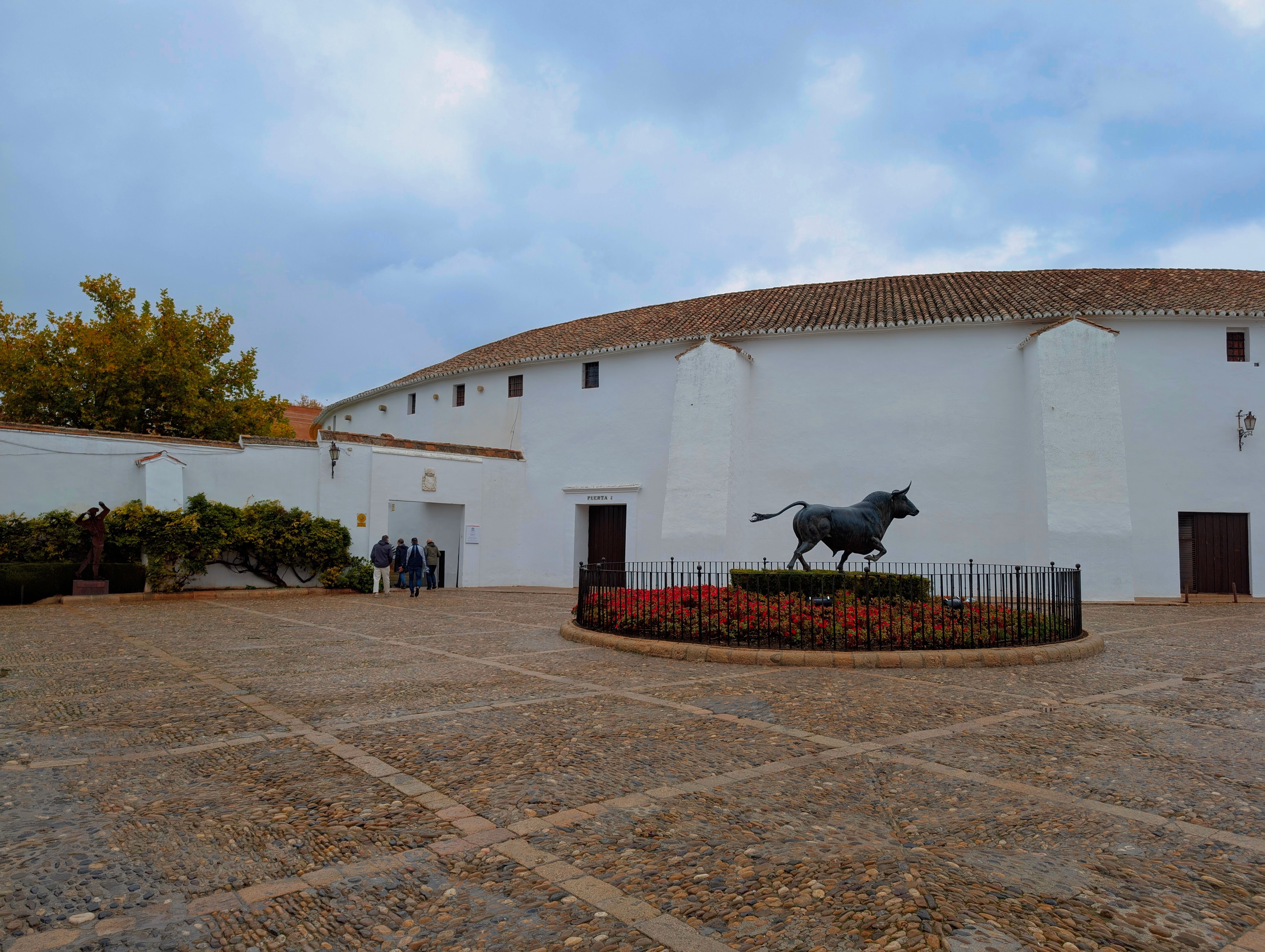
Other viewpoints/Miradors
Ronda has many other viewpoints or miradors around town, which help you get panoramic views of the town and valley around.
- Mirador de Ronda: This viewpoint right by the bull ring has spectacular views of the valley, lower Ronda, the bridge and the canyon.
- Balcón del Coño: Inside a pretty little park called Alameda del Tajo, this viewpoint has stunning views of the valley below from the sheer vertical rock faces that Ronda sits on.
- Mirador de los Viajeros Románticos: Not really a view point in my opinion but this spot has a cute mural and is 100 meters from Puente Nuevo.
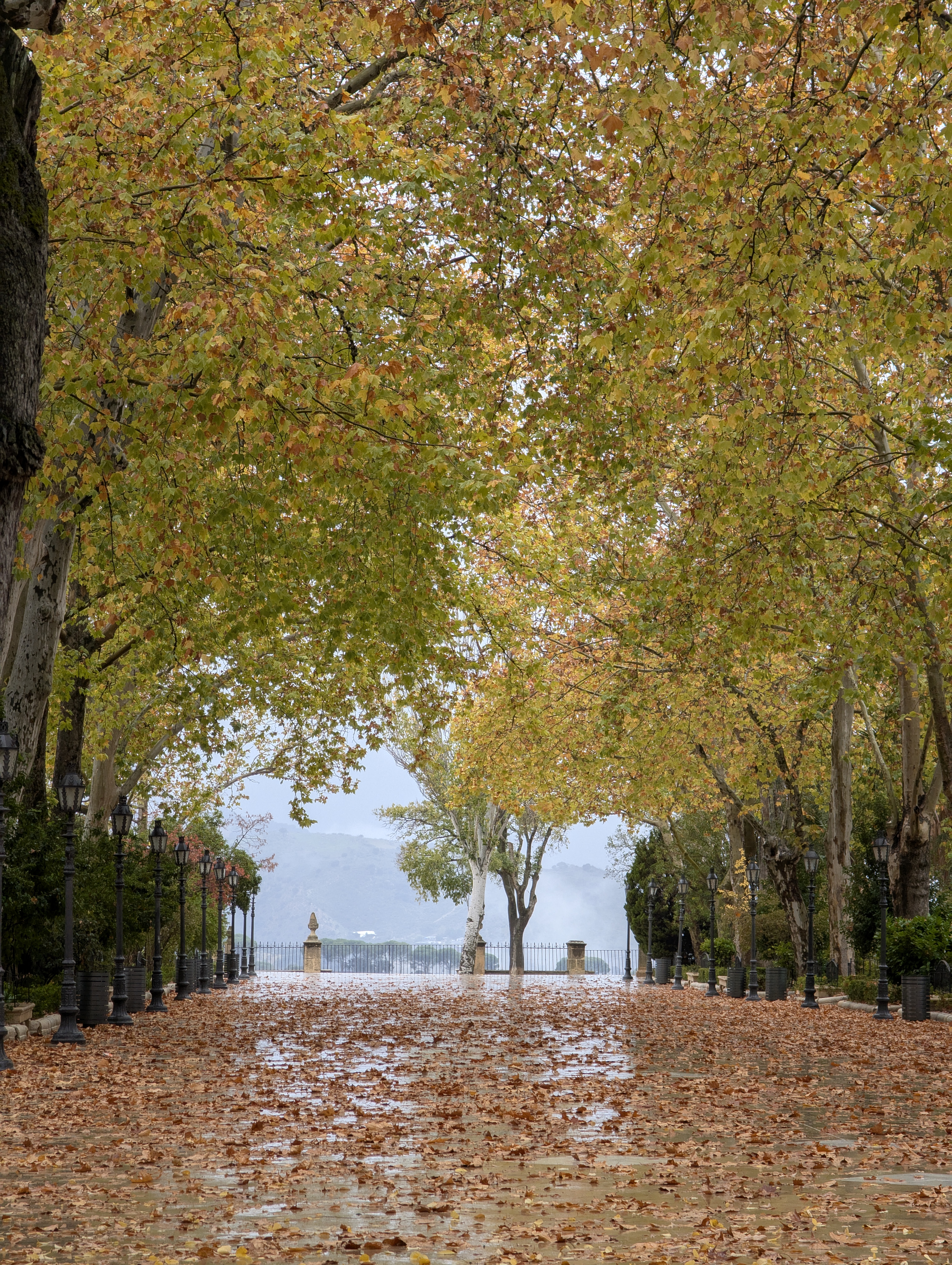
Grab lunch or dinner at a local eatery
Ronda has many great options for local tapas and a beer or wine. We got this list of recommendations from a local and hope they help you eat some amazing meals during your trip!
🍴Bar El Lechuguita is a popular spot for a casual, authentic experience.
🍴Restaurante Casa Mateos has traditional Adanlusian tapas in a cozy ambience.
🍴Entre Vinos is a tiny, local spot with great tapas and wine.
🍴Toro Tapas is another spot for great tapas.
🍴Restaurante Casa Luciano is a cute spot run by an old couple and great for multi-course meals, enabling you to try a bunch of dishes.
🍴El Morabito is a great spot for a meal with a view and some drinks.
🍴Las Maravillas is great for global options like burgers.
You can find more restaurant recommendations in our highlights map below.
Ronda Visit Highlights and Helpful Info
We’ve made a helpful Ronda map with all the highlights mentioned above and much more for your visit to Ronda.
You can find information from the tourism department of Ronda on their website here in English, Spanish and French with all the info for top sights, restaurants and other recommendations. The official website has a tonne of other helpful information and guides about Ronda as well. Below is an circular from the department on the most important tourist attractions in Ronda.
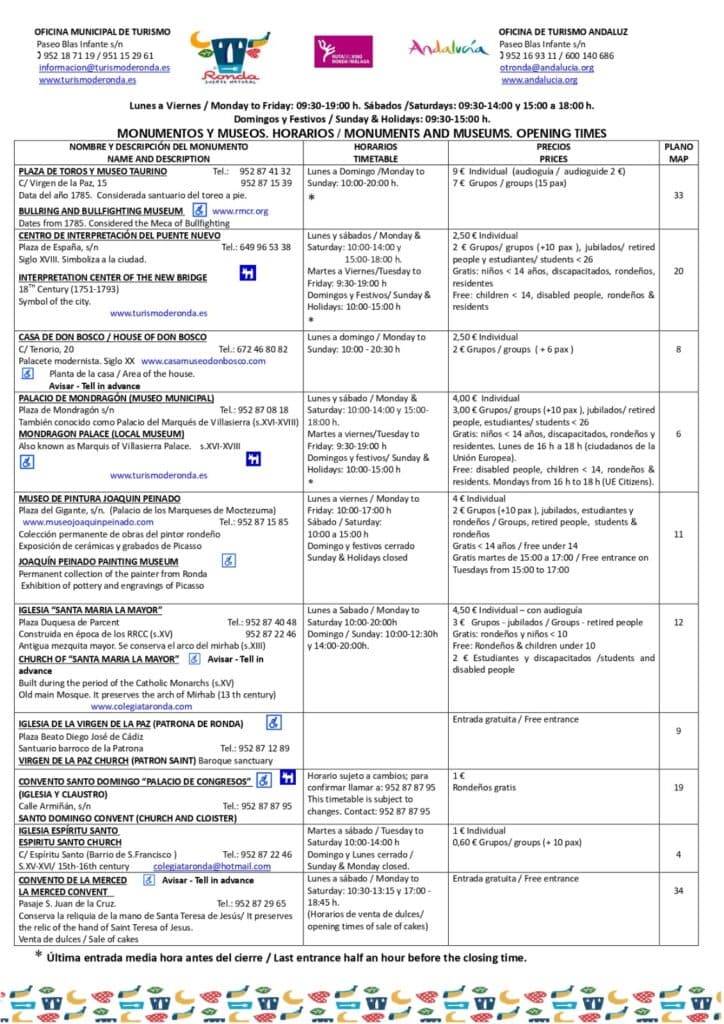
If you have more than one day in Ronda
If you have more than a day in Ronda, spend some time exploring the area around Ronda and the beautiful Andalusian white villages.
Setenil de Las Bodegas
Setenil de Las Bodegas is a unique Andalusian white village where a large part of the village has been cut into towering rock faces on either side of the Rio Trejo river / stream. Only about 20kms or 25 minutes driving time from Ronda, the drive to Setenil de Las Bodegas takes you through some beautiful highland scapes.
Spend a leisurely day here walking around the gorgeous town, checking out the various viewpoints and admiring stores, restaurants and bars carved into rock faces. Eat lunch at one of the many restaurants along Calle Cuevas del Sol. We ate at La Cueva de Isabelina which had good food and where the walls are the rock face.
Many tours from Seville, Malaga, Marbella and other cities around Andalusia that go to Ronda also take you to Setenil de Las Bodegas. If you are driving to the village on your own, beware that while there is cheap (€2) / free street parking, spaces are limited and you may end up parking far away from the center of the village. That would mean a hike up or down the hill.

Wine Tasting in Ronda
Did you know Ronda is part of a lesser-known Spanish wine region? Visit a local winery like Bodega García Hidalgo or try the wines at one of the town’s cozy bars. The local reds are particularly good.
There are plenty of wine tasting tours offered from the nearby cities of Seville and Malaga that go to Ronda and then to local wineries.
➡️From Marbella: Ronda Wine Experience Day Tour
➡️From Málaga: Ronda & Winery Experience with Wine Tasting
If you’re on a budget, check out some local wine tasting rooms – cheaper than organized tours.
Zahara de la Sierra
Zahara de la Sierra is often touted as the most beautiful pueblo blancos or white towns in Andalusia. Perched on a rocky mountain face, it overlooks a large valley and a lake. The town was founded as a Moorish outpost and its location between Ronda and Seville, it was a perfect site for a fort. Again, there are a ton of tours from around Andalusia that stop by at the village and would be your best bet to visit without your own car. If you’re driving, it is about 40 minutes driving time northwest of Ronda.
Visit the First Boutique Olive Oil Mill in the world
Andalusia takes its olives seriously. You will be driving through endless olive trees cultivated across Andalusia during your trip. Ronda has taken that love for olives to the next level by creating the La Almazara, an entire experience to celebrate everything olives. You can take a guided tour of the mill, museum and enjoy an olive oil tasting if you book here: LA Almazara LA Organic, Olive Oil Museum and Tasting. It also has great views of the valley around Ronda.
Parque Nacional Sierra de las Nieves
If you’re into hiking and have some more time to explore the area, check out Parque Nacional Sierra de las Nieves. The national park has many beautiful hiking trails taking you deep into the mountains around Ronda.
Wildlife in the park includes mountain goats and many bird species including many varieties of eagles and hawks. The official website of the park has all the information you might need on the many hiking areas within the park. If you’re interested specifically in trails around Ronda, check out their page on Ronda trails.
Best Time To Visit Ronda
Being in the mountains and on the edge of a gorge, Ronda has a temperate climate with warm, dry summers and cold, wetter winters. Summer is the best time to visit the area to take advantage of the dry, warm weather and long daylight hours. Summer goes from June – September with July and August being the hottest months. Average temperatures in summer are around a comfortable 28C or 84F.
The shoulder season in the spring and fall are also good times to visit to take advantage of the low tourist season. Average temperatures in April, May and October, November range between 15.5C – 26C or 60F-80F. The coldest it gets here is in January with minimum temperatures falling close to freezing. Generally, the summer is dry with pockets of rain through the other 8 months.
How To Get To Ronda
🎫 Day Trip Tours: There are day trip tours to Ronda, also stopping at Setenil de Las Bodegas and / or Zahara de la Sierra from Malaga, Seville, Marbella. You can also opt for the many wine tours around the area in case that is more suited to your taste.
🚗 Car: Driving is the easiest way to reach Ronda, especially if you want to explore the surrounding countryside, nearby coast, or Cadiz. Ronda is about a 2-hour drive from Seville, 1h20m from Malaga and only about an hour from Marbella making it a great stop on an Andalusia road trip.
🚆 Train: Ronda is accessible by train from cities like Seville or Malaga, with a scenic ride through the mountains. Tickets can be bought at renfe.com
🚌 Bus: Buses connect Ronda to other Andalusian towns and are a budget-friendly option. Note: the roads to Ronda are winding, so if you’re prone to motion sickness, pack some ginger candy or motion sickness pills. You can book bus tickets on Omio.
Where To Stay In Ronda
Some hotels have terraces overlooking the gorge – totally worth the splurge for one night.
Luxury and mid-range options
📍Hotel Catalonia Reina Victoria
📍Hotel Soho Boutique Palacio San Gabriel
Budget options
📍Ronda Hotel Polo: This is where we stayed and it was a really cute hotel run by an Asian-Spanish couple with a beautiful terrace.
TLDR: Is Ronda, Spain Worth Visiting?
Yes, Ronda in Spain is definitely worth visiting, either on it own or combined with the beautiful white villages / towns around it that are a feature of Andalusia in general. The stunning location of the town on vertical rock cliffs overlooking a deep gorge make it a unique travel destination. You’ll love the history, architecture, culture, food and nature of Ronda.

